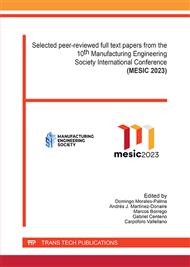p.475
p.485
p.494
p.502
p.511
p.523
p.531
p.540
p.549
Creation of a Model of a Cutting Tool Using Additive Manufacturing for Visualization of Machining Angles
Abstract:
Additive Manufacturing (AM) represents a technology that provides access to part designs that are impossible or very difficult to achieve by any other manufacturing process. In addition to this consideration, the possibility of customization, and consequently, the almost immediate adaptation of dimensions and geometries makes the AM an exceptional alternative in the manufacture of prototypes. From the experience in the teaching of subjects in the Manufacturing Processes Engineering Area, it has been in different aspects of them that a special difficulty has been detected by the students in the spatial visualization of the concepts. A case of this, of special relevance, is that of the main cutting angles in a machining tool (with two cutting edges, main and secondary). In this work, a proposal for teaching innovation is proposed through the materialization of a removable model made with AM of a cutting tool in which different elements can be broken down, giving rise to the different angles indicated above. The students can operate with it, observing the angle of interest. The possibility of manufacturing with different polymeric, composite or metallic materials, of making modifications to the original designs to alter the contemplated angles and create new model configurations, the precise adjustment of the different pieces due to the non-appearance of a gap between them, the use of a wide range of colors for each piece or set of them, and changes in scale and so on, offer the possibility of expanding this work to any other type of cutting tools.
Info:
Periodical:
Pages:
523-530
Citation:
Online since:
October 2023
Price:
Сopyright:
© 2023 Trans Tech Publications Ltd. All Rights Reserved
Share:
Citation:



